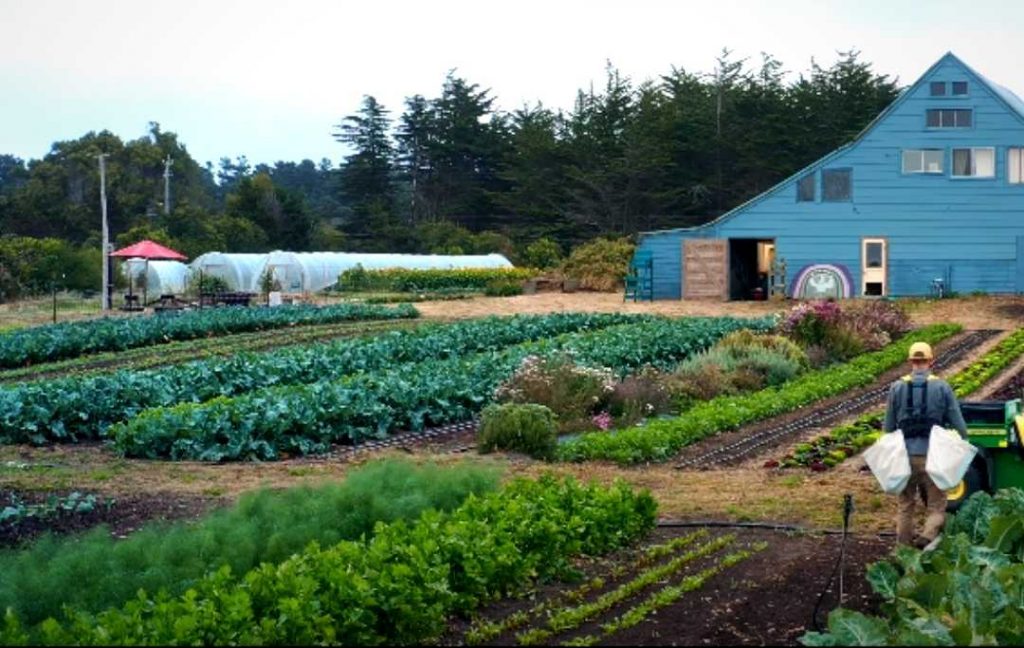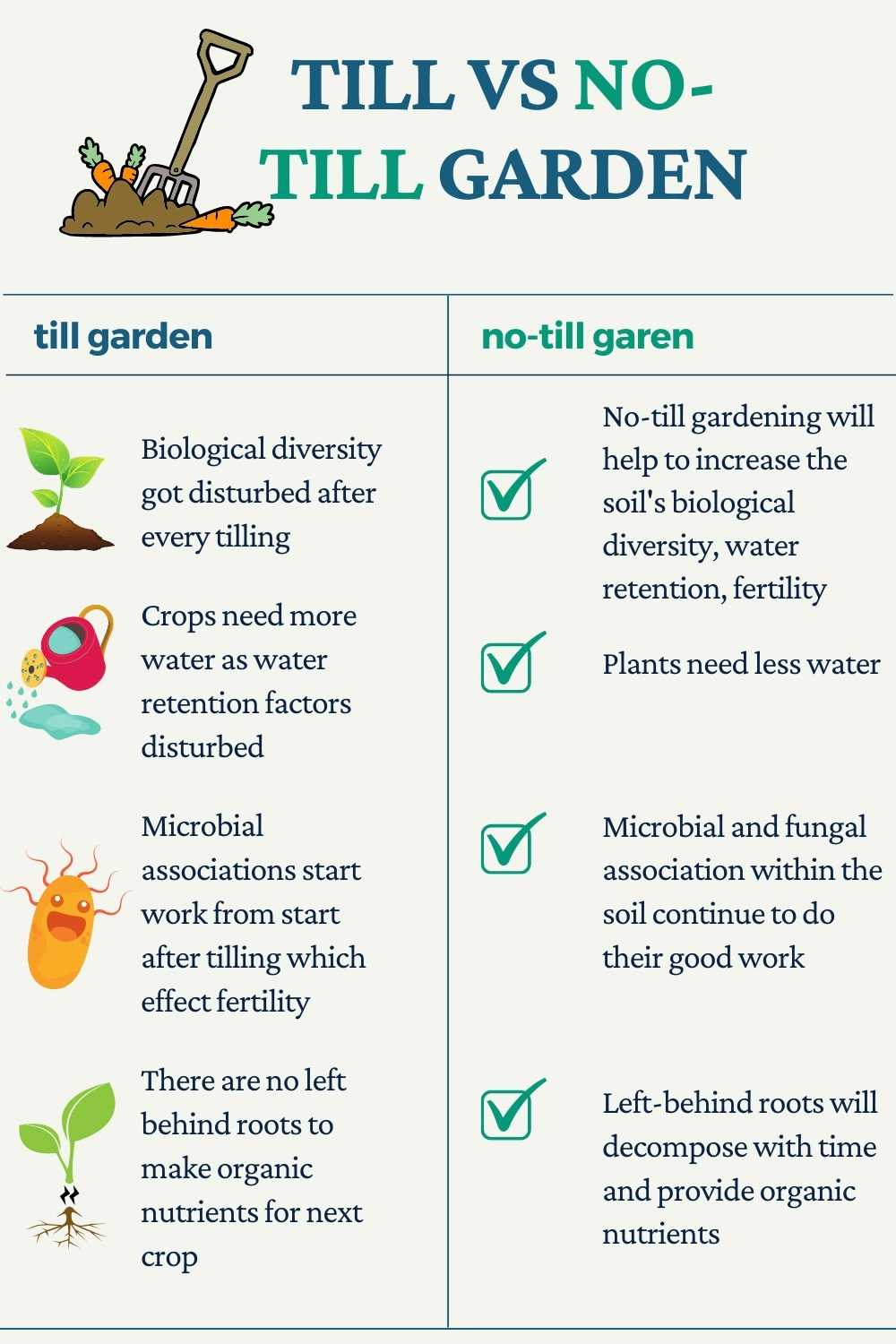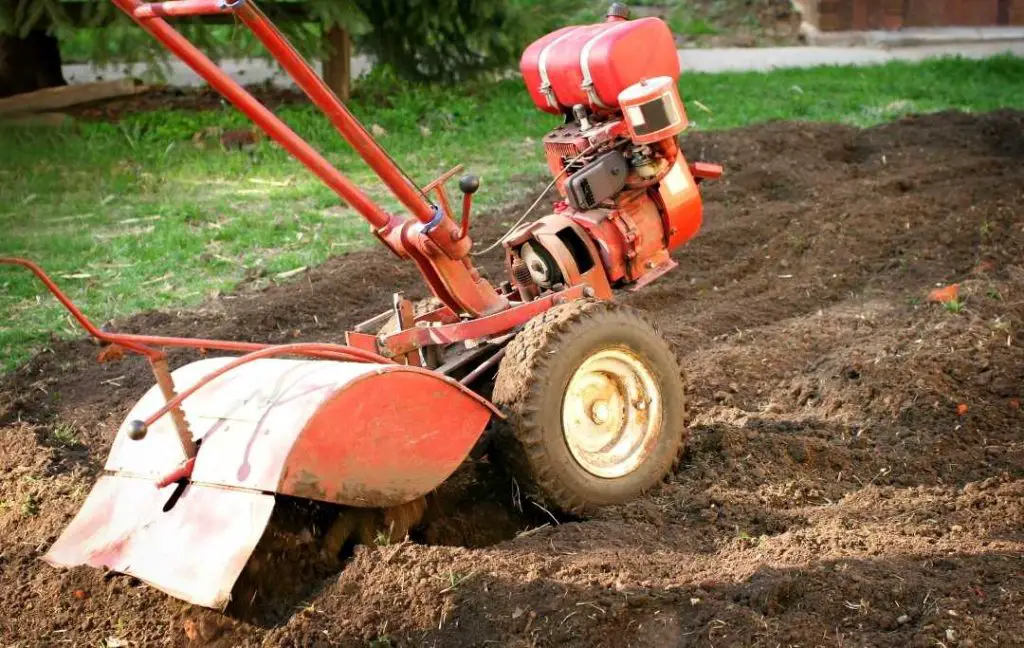If you don’t want to spend your time and effort, you should turn to the no-till or no-dig gardening method.
No-till gardening has many benefits but you can’t use this method for every garden or growing plot.
First of all, we shall see what is the difference between the till and no-till method.
WHAT IS THE NO-TILL METHOD?

If you want that nature to take more control over your garden, you should choose the no-till gardening method. In this method, you will grow crops without disturbing the land with tillage.
No-till gardening is also known as No-dig gardening, in this method, you avoid the intentional disruption of soil. Spades, hoes, and other tools are not used in this method. In this way, the roots of the plants remain untouched.
When the growing season ends, we cut plants with the help of pruners or hand saws. You should not pull out the entire plant and root system from the soil. The left-behind plant roots slowly break down in the soil and provide food to your new plants.
In this method instead of mixing the organic nutrients or material such as compost, organic fertilizers, or mulch into the soil you should add them to the top of the soil. In this way, you will provide a natural wild environment of forest floor or meadow in your garden.
ADVANTAGES OF NO-TILL GARDENING
When you allow nature to take over the control of your garden then the health of the soil will boost. If you are done correctly then you will get a lot of advantages from the no-till gardening method.
- No-till gardening will help to increase the soil’s biological diversity, water retention, fertility, and production of the crop during the growing season.
- If you do not till the soil then the air pores are preserved and soil will become compacted. In this way, your plants need less water for irrigation purposes.
- The critters such as established a beneficial microbial and fungal association within the soil continue to do their good work. If you till the soil then the microbial activity within the soil comes to an end. These insects are very beneficial and create a natural environment within the soil.
- The left-behind roots will decompose with time and provide organic nutrients to microorganisms and worms in the soil. These nutrients are very important during the growing process of plants.
- Last but not least no-till gardening can save your time, effort, and physical labor. This method makes your work easier like preparing a raised bed or in-ground beds and planting crops.
HOW TO PRACTICE NO-TILL GARDENING?
No-till gardening doesn’t mean that you have to do nothing to get a healthier crop. We are going to explain no-till gardening step by step.
REMOVING PLANTS AND ADDING NEW
When the growing season ends then the time comes to remove the old plants from your garden. There is no need to pull plants from the soil. We cut the old plants out at the base of the plant.
You are thinking that the left behind stalks and roots make trouble for the new growing plants but don’t worry the left-behind plants make food for your new plants.
After cutting the plants, apply a layer of mulch. This will help to keep the soil moist and after adding amendments you can start planting again in spring.
COMPOST, FERTILIZER, AND MYCORRHIZAE
You should add organic materials at least once or twice per year. The organic material included such as fine-needles, aged compost, leaf mold or dry leaves, wood chips, fine bark, and natural mulch material.
At the top of your raised garden beds on in-ground beds, you can add a layer of an inch of organic materials such as compost. After that sprinkle, slow-release fertilizer like alfalfa, crab, kelp, and neem meals.
When planting time comes, you can add worm casting and mycorrhizae. Worm casting is a slow-release fertilizer that helps to improve the structure of the soil. Mycorrhizae is a type of fungi that helps to extend the surface area and function of the roots of the plant which you are growing.
You can also use different things to increase the richness of the soil. For example, aerated compost tea is also used to feed the fruit trees and vegetables of your garden.
If you are growing plants in the greenhouse then diluted seaweed extract or aloe vera soil drench is a great option for your greenhouse seedlings.
WORMS
Worms are a very important part of a no-till gardening system. If we talk about their functions then you will be amazed that they are working naturally in the soil of your garden.
The other important work of worms is to help the nutrients in moving around. They also help to break down organic matter which is very beneficial for the healthy growth of your plants. If you are growing plants in the ground then the earth’s worms easily find their way.
When we grow plants in a raised bed then we use landscape fabric at the bottom of the raised bed to prevent your plants from the weeds. Due to fabric cloth, worms can’t enter the soil. In that case, you can add a small handful of worms to the raised bed at the time of filling with soil.

DISADVANTAGES OF NO-TILL GARDENING
Following are the disadvantages of the no-till gardening method.
- The no-till gardening method takes time, it means it needs patience because soil needs time to regain structure. It doesn’t happen within one day.
- At the end of the growing season, when you do not pull out the plants but cut them. Then there is a risk of spreading disease when the older crop residue is not Incorporated after harvesting.
WHAT IS TILLING?
This is the second part of the article in which we will discuss what is tilling. Tilling is a process in which we simply turn over and break up the soil. Now the question arises in your mind how deep you will tIll the soil. It will depend upon the reason for tilling.
WHEN TILLING MAY HELP

We have discussed all the benefits of no-till gardening. Now we will talk about when we should till the soil. When spring comes you always plant new flowers and plants in your garden.
Never till the soil when it is wet because it will damage the valuable existing structure which is needed during the growth of your plants. First, you should check the soil if it is dry then insert or trowel.
If you feel it is very difficult to insert the trowel then it means the soil is dry and it is ready for tilling. Here are some reasons when the soil needs to be tilled.
1- STARTING FRESH
The no-tilling gardening method will save time and money. But in some cases, you have to tell your garden especially when you are starting a new in-ground garden bed and the composition of the soil is not ideal.
The tilling will work best if you add aged compost and other natural materials such as leaves or wood chips into any type of soil. You should not dig down too deep.
If you are going to start a new garden in your lawn area that is another unacceptable time to till. Tilling is a very effective way to kill or remove grass to prepare the area for growing new plants.
The beds which are established enough sometimes also need tilling. If the soil of your beds becomes too dense or rocky then you can not grow deep-rooted plants such as carrots in them.
In that situation, you have to mix horticultural sand or potting mix in the soil. This will help to loosen the soil in that area where you want to start your new crop. Digging will help you to remove unwanted rocks around the area and make planting easier for you.
2- REMOVING PESKY OR DISEASED ROOTS
If you want to get rid of those affected roots which are responsible for spreading diseases then it is a wise decision to pull those roots out. For instance, if you are growing mint or any plant that is good at growing back from suckers.
You should remove the roots from the diseased plants so they will not affect the new growing plants. In the no-till gardening method, rather than pulling out the plant from the soil, we simply cut the plants and leave the roots in the soil.
These left-behind roots of the plants will help the soil to become rich. But if the plants are affected by diseases then you should not cut the plants but pull them from the soil. Affected plants are not good for new plants.
3- ROOT-KNOT NEMATODES
If there is an infestation of root-knot nematodes then the no-till gardening method will not work. These microscopic pests get their food from the roots of the plants.
It is necessary to remove these infected roots by tilling and exposing the soil name to air. This will help to reduce the population of nematodes in the soil.
Solarization is another way of getting rid of this problem. Solarization is a process in which you will cover the soil with plastic for many weeks. During the hot days of summer. You can also grow marigold as a companion plant because the roots are very toxic to root-knot nematodes.
4- TILLING FOR SEVERELY COMPACTED SOIL
If the soil of your garden is very compacted then there is a need to tilling it. Compacted soil is very heavy due to the clay in this soil. The roots of the plant are not able to push through and grow.
For breaking up compact soil you need to till the soil. Dig the dry soil up to 10 to 12 inches deep. At this stage, you should leave the overturns soil for 2 to 3 days.
When you see the soil is dry then after that, you have to add a layer of 2 to 3 inches of organic matter compost or rotted manure to the soil so it will help to lose the texture.
DISADVANTAGES OF TILLING
Tilling is beneficial but sometimes you should think twice before tilling soil every spring. Following are the reasons why you should not till the soil.
- The worms which are naturally present in the soil helps to aerate and fertilize it. After digging and casting they are killed.
- After the tilling action, the weeds which are under the ground can germinate and start producing new weeds.
- Tilling aerates the soil but too much addition of air becomes the reason for burning up humus. If this happens the plants will not get the full advantage of the nutrients.
